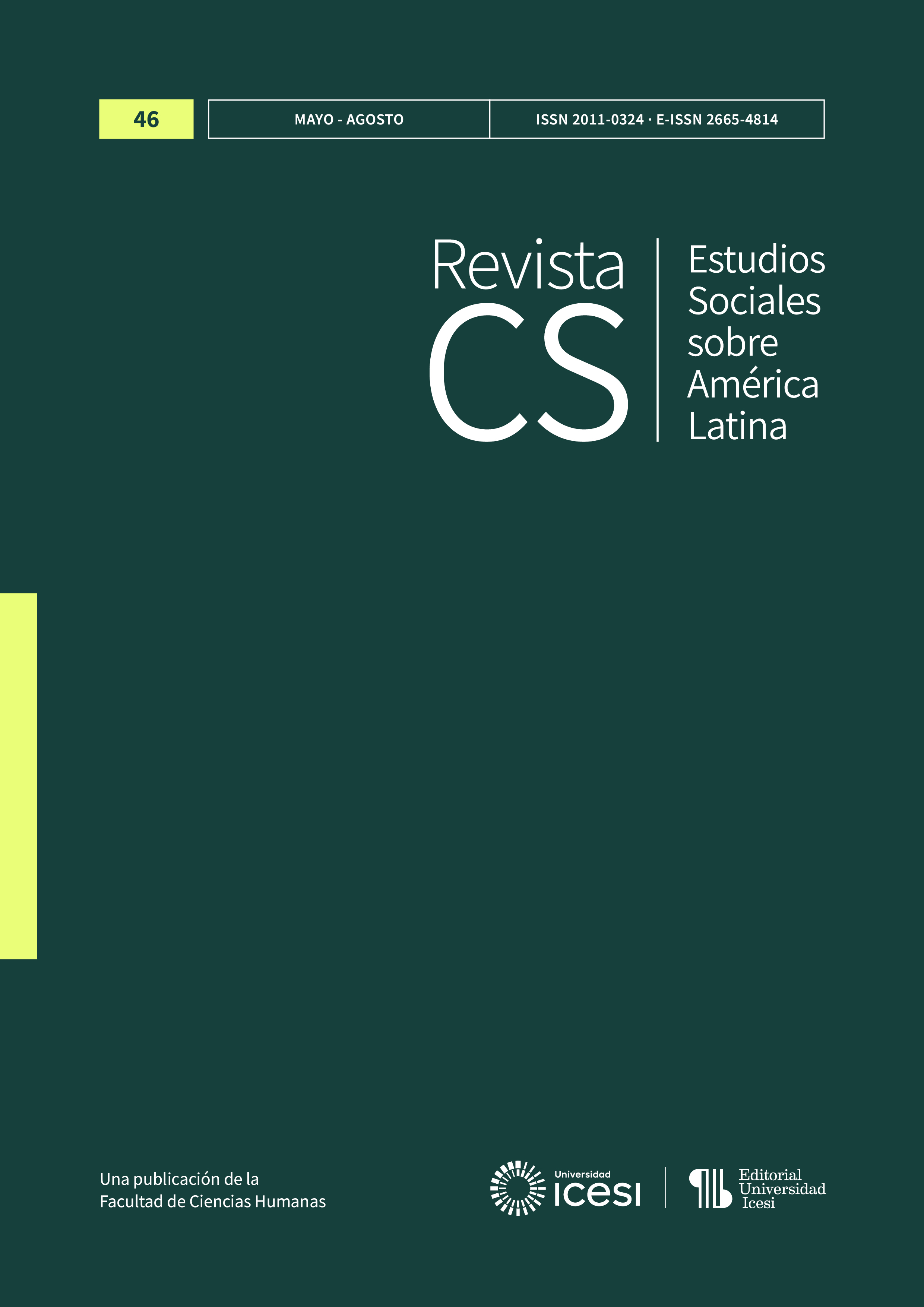Technological practice to safeguard and promote native languages from Vaupés
DOI:
https://doi.org/10.18046/recs.i46.03Abstract
This study analyzes the use of digital technologies in a project aimed at strengthening local capacities in native language research in the department of Vaupés, Colombia. Using an interdisciplinary approach, we developed several digital resources, including a digital research repository, a bulletin board, a web page, and multimedia content in the native language and Spanish. Inspired by the concept of technological practice, we argue that technology can enhance native language safeguarding processes if it is viewed as a system involving technical, organizational, and cultural aspects. Related concepts such as social appropriation of knowledge and scientific communication were implemented to work on organizational and cultural aspects, through transmedia content, and address communication needs in a multilingual and culturally diverse territory. This work contributes to showing how technologies as a practice can provide technically robust, culturally appropriate, and sustainable solutions.
Downloads
References
Aboelela, Sally; Larson, Elain; Bakken, Suzzane; Carrasquillo, Olveen; Formicola, Allan; Glied, Sherry; Gebbie, Katherine (2007). Defining Interdisciplinary Research: Conclusions from a Critical Review of the Literature. Health Services Research, 42(1), 329-346. https://doi.org/10.1111/j.1475-6773.2006.00621.x
Aguirre, Javier; Canacué, Mariana; Delgado, Valentina (2025). Soluciones multimedia para la conservación y fortalecimiento de las lenguas nativas. En Vaupés multilingüe. Experiencia del fortalecimiento de capacidades locales para la investigación y promoción de las lenguas nativas (pp. 105-128), editado por Adela Parra-Romero; Robin Castro-Gil. Cali: Universidad Icesi.
Aikhenvald, Alexandra (2006). Semantics and pragmatics of grammatical relations in the Vaupés linguistic area. En Grammars in contact: a cross-linguistic typology (pp. 237-266), editado por Alexandra Y. Aikhenvald; R. M. W. Dixon. Oxford: Oxford University Press.
Blue, Gwendolyn (2019). Science Communication Is Culture: Foregrounding Ritual in the Public Communication of Science. Science Communication, 41(2), 243-253. https://doi.org/10.1177/1075547018816456
Castelfranchi, Yurij; Fazio, María Eugenia (2021). Comunicación pública de la ciencia. Montevideo: UNESCO. Recuperado de http://forocilac.org/wp-content/uploads/2021/04/PolicyPapers-CILAC-ComunicacionPublicaCiencia-ES.pdf
Chernela, Janet Marion (2013). Toward a Tukanoan ethnolinguistics: Metadiscursive practices, identity, and sustained linguistic diversity in the Vaupés basin of Brazil and Colombia. En Upper Rio Negro: Cultural and linguistic interaction in Northwestern Amazonia (pp. 197-244), editado por Patience Epps; Kristine Stenzel. Río de Janeiro: Museu do Índio/FUNAI, Museu Nacional.
Dhamdhere, Kedar; McCurley, Kevin Snow; Nahmias, Ralfi; Sundararajan, Mukund; Yan, Qiqi (marzo, 2017). Analyza: Exploring data with conversation. Trabajo presentado en 22nd International Conference on Intelligent User Interfaces (IUI 2017), Association for Computing Machinery (ACM), Limassol, Chipre. https://doi.org/10.1145/3025171.3025227
Esbach, Michael; Correia, Joel; Valdivia, Gabriela; Lu, Flora (2024). Amazonian conservation across archipelagos of Indigenous territories. Conservation Biology, 39(2) 1-12. https://doi.org/10.1111/cobi.14407
González, Marta Isabel; López-Cerezo, José Antonio; Luján-López, José Luis (2000). Ciencia, tecnología y sociedad. Una introducción al estudio social de la ciencia y la tecnología. Madrid: Tecnos.
Heinrich, Anna Juliane; Heitmayer, Maxi; Smith, Eva Marlena; Zhang, Yifan (2025). Experiencing hybrid spaces: A scoping literature review of empirical studies on human experiences in cyber-physical environments. Computers in Human Behavior, 164, 1-15. https://doi.org/10.1016/j.chb.2024.108502
Hughes, Thomas Parker (1983). Networks of power: Electrification in Western Society, 1880-1930. Baltimore: Johns Hopkins University Press.
Huilcán-Herrera, Marcela Isabel (2022). The use of technologies in language revitalisation projects: Exploring identities. Journal of Global Indigeneity, 6(1), 1-17. https://doi.org/10.54760/001c.36061
Huutoniemi, Katri; Klein, Julie; Bruun, Henrik; Hukkinen, Janne (2010). Analyzing interdisciplinarity: Typology and indicators. Research Policy, 39(1), 79-88. https://doi.org/10.1016/j.respol.2009.09.011
Jackson, Jean Elizabeth (2010). La política de la práctica etnográfica en el Vaupés colombiano. En Perspectivas antropológicas sobre la Amazonia contemporánea (pp. 233-265), compilado por Margarita Chaves-Chamorro; Carlos Luis del Cairo-Silva. Bogotá: Pontificia Universidad Javeriana/ICANH.
Junker, Marie Odile; Stewart, Terry (julio, 2011). A Linguistic Atlas for Endangered Languages: www.atlas-ling.ca. Trabajo presentado en EDULEARN11: International Conference on Education and New Learning Technologies, IATED, Barcelona, España.
Klein, Julie (2021). Beyond Interdisciplinarity. Boundary Work, Communication, and Collaboration. Oxford: Oxford University Press. https://doi.org/10.1093/oso/9780197571149.003.0004
Latour, Bruno (2005). Reensamblar lo social. Una introducción a la teoría del actor-red. Buenos Aires: Manantial.
Leahey, Erin (2016). From Sole Investigator to Team Scientist: Trends in the Practice and Study of Research Collaboration. Annual Review of Sociology, 42, 81-100. https://doi.org/10.1146/annurev-soc-081715-074219
Leigh, Jennifer; Brown, Nicole (2021). Researcher experiences in practice-based interdisciplinary research. Research Evaluation, 30(4), 421-430. https://doi.org/10.1093/reseval/rvab018
Lievrouw, Leah; Livingstone, Sonia (2002). Handbook of new media: Social shaping and social consequences of ICTs. Londres: Sage.
Loan, Fayaz Ahmad (2014). Open Access Digital Repositories in Asia: Current Status and Future Prospects. International Journal of Information Science and Management, 12(2), 35-45. Recuperado de https://ijism.isc.ac/article_698208_4718b5855ea5ce4044c581d2bef0bc16.pdf
López-Macías, Gabriel; López-León, Ricardo; Mollenhauer-Gajardo; Katherine (2020). Etnodiseño: modelo de diseño desde la perspectiva etnográfica y su aporte a la formación en diseño. I+Diseño. Revista Científico-Académica Internacional de Innovación, Investigación y Desarrollo en Diseño, 15, 23-40. https://doi.org/10.24310/Idiseno.2020.v15i0.9574
Martínez-Costa, María Pilar; Lus-Gárate, Eva (2019). El éxito de los pódcasts de noticias y su impacto en los medios de comunicación digital. Miguel Hernández Communication Journal, 10(2), 317-334. https://doi.org/10.21134/mhcj.v10i0.314
Massarani, Luisa; Moreira, Ildeu de Castro (2016). Science communication in Brazil: A historical review and considerations about the current situation. An Acad Bras Cienc, 88(3), 1577-1595. https://doi.org/10.1590/0001-3765201620150338
Meighan, Paul John (2021). Decolonizing the digital landscape: the role of technology in Indigenous language revitalization. AlterNative, 17(3), 397-405. https://doi.org/10.1177/11771801211037672
Ministerio de Ciencia, Tecnología e Innovación (2020). Lineamientos para una Política Nacional de Apropiación Social del Conocimiento. Recuperado de https://minciencias.gov.co/sites/default/files/documento_de_lineamientos_para_la_politica_nacional_de_apropiacion_social_del_conocimiento_1.pdf
Nass de Ledo, Ingrid (2012). La página web. Revista Venezolana de Oncología, 24(3), 191. Recuperado de https://www.redalyc.org/pdf/3756/375634873001.pdf
Nikitenko, Vitalina; Voronkova, Valentyna; Oleksenko, Roman; Kyvliuk, Olga; Klochek, Liliia; Koliada, Natalia…; Drachuk, Mariana (2025). Developing the Concept of Digital Humanism as Human Interaction with Artificial Intelligence. Pakistan Journal of Life and Social Sciences, 23(1), 238-248. https://doi.org/10.57239/PJLSS-2025-23.1.0021
Ong, Walter Jackson (2006). Oralidad y escritura: Tecnologías de la palabra. Buenos Aires: FCE.
Organización para la Cooperación y el Desarrollo Económico - OCDE (2015). Manual de Frascati 2015: guía para la recopilación y presentación de información sobre la investigación y el desarrollo experimental. FECYT. Recuperado de https://www.oecd.org/content/dam/oecd/es/publications/reports/2015/10/frascati-manual-2015_g1g57dcb/9789264310681-es.pdf
Osorio, Carlos (2014). Enfoques sociales sobre los sistemas tecnológicos. Trilogía Ciencia Tecnología Sociedad, 6(11), 11-32. https://doi.org/10.22430/21457778.495
Pabón, Rafael (2017). Apropiación social del conocimiento: una aproximación teórica y perspectivas para Colombia. Educación y Humanismo, 20(34). https://doi.org/10.17081/eduhum.20.34.2629
Pacey, Arnold (1990). La cultura de la tecnología. México: FCE.
Pacey, Arnold (2014). Technology: Practice and Culture. En Ethics and Emerging Technologies (pp. 27-36), editado por Ronald Sandler. London: Palgrave Macmillan. https://doi.org/10.1057/9781137349088_2
Parra- Romero, Adela (2025). Análisis del campo de la investigación y documentación sobre lenguas nativas del Vaupés. En Vaupés multilingüe. Experiencia del fortalecimiento de capacidades locales para la investigación y promoción de las lenguas nativas (pp. 105-128), editado por Adela Parra-Romero; Robin Castro-Gil. Cali: Universidad Icesi.
Parra-Romero, Adela; Castro-Gil, Robin (eds.) (2025). Vaupés multilingüe. Experiencia del fortalecimiento de capacidades locales para la investigación y promoción de las lenguas nativas. Cali: Universidad Icesi.
Quintanilla, Miguel Ángel (1988). Tecnología: Un enfoque filosófico. Madrid: Fundesco.
Rodríguez, Marcelo Sergio (2019). Conocimiento y poder en el Modelo de Déficit: una aproximación epistemológica a la comunicación pública de la ciencia y la tecnología. Tecnología & Sociedad, 8, 31-57. Recuperado de https://erevistas.uca.edu.ar/index.php/TYS/article/view/2764
Romaine, Suzanne (2007). Preserving Endangered Languages. Language and Linguistics Compass, 1(1-2), 115-132. https://doi.org/10.1111/j.1749-818X.2007.00004.x
Ross, Charlotte; Greyeyes, Joan; McIvor, Onowa (2021). Breathing life back into the stories: Creating the circle of Indigenous languages website. WINHEC: International Journal of Indigenous Education Scholarship, 16(1), 302-333. https://doi.org/10.18357/wj161202120290
Scolari, Carlos Alberto (2014). Narrativas transmedia: nuevas formas de comunicar en la era digital. Anuario AC/E de Cultura Digital, 71-81. Recuperado de https://www.accioncultural.es/media/Default%20Files/activ/2014/Adj/Anuario_ACE_2014/6Transmedia_CScolari.pdf .
Seguí-Simarro, Jose María; Poza-Luján, José Luis; Mulet-Salort, José Miguel (2015). Estrategias de divulgación científica. Valencia: Universitat Politécnica de Valencia. Recuperado de https://riunet.upv.es/bitstream/handle/10251/66785/TOC_6206_01_01.pdf?sequence=7
Selwyn, Neil (2011). Education and technology: Key issues and debates. London: Continuum International Publishing Group.
Stringer, David (2018). Quando gafanhoto significa relâmpago: como o conhecimento ecológico é codificado nas línguas ameaçadas. Ecolinguística: Revista Brasileira de Ecologia e Linguagem, 4(2), 41-48. Recuperado de https://periodicos.unb.br/index.php/erbel/article/view/12361
Suri, Fulton (2015). The little book of design research ethics. IDEO
Ulfe, María Eugenia; Vergara, Roxana; Romo, Vanessa (2021). “Nuestras historias desde Cuninico”: Pódcasts, pandemia e investigación antropológica. LASA Forum, 52(1), 13-18. Recuperado de https://es.scribd.com/document/557493137/Ulfe-Vergara-y-Romo-2021
Von Linsingen, Irlan (2007). Perspectiva educacional CTS: aspectos de um campo em consolidação na América Latina. Ciência & Ensino, 1(1), (número especial), 1-19. Recuperado de http://179.108.116.1:3537/ojs/index.php/cienciaeensino/article/view/150/108
Downloads
Published
Issue
Section
License
Copyright (c) 2025 Adela Parra-Romero, Robin Castro-Gil, Alejandro Peñaranda, Manuela Triviño

This work is licensed under a Creative Commons Attribution-NonCommercial 4.0 International License.
© Reserved Copyright
Material in this publication may be reproduced without authorization, provided the title, author and institutional source is acknowledged.
The content published in Revista CS is distributed under the Creative Commons BY-NC 4.0 Attribution/Recognition-NonCommercial 4.0 International license.
You are free to:
Share — copy and redistribute the material in any medium or format.
Adapt — remix, transform, and build upon the material.
Under the following terms:
Attribution — You must give appropriate credit , provide a link to the license, and indicate if changes were made . You may do so in any reasonable manner, but not in any way that suggests the licensor endorses you or your use.
NonCommercial — You may not use the material for commercial purposes.












